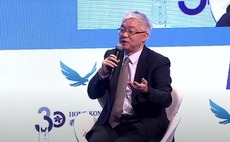
China biotech: Finding the formula
An eruption of investment and company creation in Chinese biotech has signaled the dawn of a raw but promising market. First-movers must negotiate immediate pitfalls while targeting long-term upside
The policy that ended up sparking China's booming biotechnology space was never drafted with advanced life science laboratories in mind, nor the emerging middle class that is increasingly willing and able to spend money on treatments. Instead it was a revamp of a collapsed 1970s-era insurance program intended to improve access to basic healthcare in rural areas.
Since the New Cooperative Medical Scheme was implemented in 2003, the establishment of a list of drugs that are coverable by government insurance has resulted in an explosion of interest from pharmaceuticals manufacturers eager to get their products officially recognized. VCs routinely describe this period as a time when the biotech space grew from only a handful of noticeable players to an ecosystem of hundreds of start-ups.
The avalanche moment appears to have been triggered relatively recently. According to AVCJ Research, Chinese private equity and venture capital investment in drug developers has increased exponentially since 2014, when commitments totaled $306.2 million. This figure reached $1.3 billion last year and has already eclipsed $2.1 billion in 2018 to date.
The surge in appetite – reflected by a proliferation in specialist healthcare funds as well as generalist GPs looking to deploy more capital in the sector – has led to concerns around high valuations and the ability to effectively deploy rising levels of dry powder. Standout deals have included Brii Biosciences and CStone Pharmaceuticals, each of which received early-stage rounds worth $260 million.
"About two years ago, a lot of people were talking about acquiring hospitals, but now many of those same people are talking about developing drugs," says Jonathan Wang, a senior managing director and founding partner at OrbiMed Asia. "When investors get overly optimistic about a hot area and into a herd mentality, you'll see this phenomenon. Too high a cost is always a big risk for investors, and in this case, the cost is getting significantly higher than usual."
The momentum redoubled in 2009 when another insurance policy push tacked on provisions for speeding up the process of bringing advanced foreign drugs into the domestic market, which has been historically dominated by generics and characterized by a sluggish approvals process. These efforts culminated last month with a move to allow experimental overseas drugs to continue their development inside China without going through the usual re-trialing process for local regulators.
Market oversight has also been a factor at the local level, with the Suzhou and Hangzhou governments notably fostering the country's first biotech hubs. Perhaps most encouragingly, the Hong Kong Stock Exchange (HKEx) has recently opened its doors to pre-revenue biotech companies. This is seen as both a reaction to the government-initiated boom and a perpetuator of some of the most recent activity from the private sector because it provides investors with a regional exit option before commercialization.
Unchartered territory
All of this is new territory for China. Since the 1970s, the global, US-led biotech industry has experienced at least four major boom-bust cycles. Now China is undergoing its first biotech upcycle in the context of massive pollution, aging and lifestyle pressures that have created the world's largest supply-demand gap for new drugs. At the same time, an influx of returning Chinese biotech professionals who cut their teeth overseas are now looking to carve out a piece of the growing opportunity back home.
The US and other developed biotech markets are logically proving invaluable channels in this knowledge transfer process through the provision of both people and intellectual property (IP). However, the most experienced investors have begun to balk at participating directly as deal valuations inflate, especially in the later-stage rounds.
"China has not seen a downcycle yet in this industry, so when companies fundraise at high valuations, people are throwing money at them as if everything will be successful," says James Huang, founder of Panacea Venture and a general partner at KPCB China. "That's a phenomenon that doesn't exist in the US, where the venture community is still very careful about every deal, and they're trying to figure out how to tranche deals to hedge their risk. We're not seeing that in Greater China."
Panacea spun out from KPCB China last year with a view to bucking the current trends around large funds bankrolling expensive IP transfers from West to East. The firm's debut vehicle is oversubscribed and expected to formally close around the $150 million mark in the next few weeks. The plan is to make tightly targeted investments exclusively in young companies developing original products in-house.
Pivotal Bioventure Partners, by contrast, has made in-licensing US biotech IP for Chinese markets a core part of its risk mitigation strategy and demonstrated the speed benefits of the approach this year by leading a $16.5 million seed round for Sino-US cancer drug developer Oncologie. Within only a few months of its formation, the start-up has been able establish a portfolio of three clinical-stage assets. The success has been attributed in part to a cross-border game plan around trialing, incubation, and team building.
"We cannot have a purely global team with no Chinese experience or a Chinese team with no global experience – it has to be a mixture," says Jimmy Wei, a managing partner at Pivotal. "An ideal candidate will have worked for large biotech companies overseas and be able to bring that skillset to China by copying global protocols, thinking and designs."
Know your team
Most of the risk around evaluating biotech companies is arguably team-based, especially given the industry's reputation for talent shortages and rapid staff turnover. To some extent, the risk is being offset at an industry level through the establishment of talent incubators such as Zhangjiang Hi-Tech Park in Shanghai, Suzhou Biobay, and Wuhan Biolake. But team-building work is increasingly being seen as a precaution that needs to be handled by individual GPs.
In addition to Pivotal, firms pursuing incubation models include Lilly Asia Ventures, C-Bridge Capital and Panacea, which describes its program as perhaps the only one globally whereby the fund manager absorbs the incubation costs instead of the LPs. This approach is seen as more expensive in the immediate term but ultimately more economic since it mitigates the downside related to perfecting team chemistry in an industry with a transient skills base.
Panacea's Huang notes that finding the best people in their respective disciplines is not sufficient if they cannot prove that they are capable of working together and enduring the inevitable hardships of growing a biotech company across various cycles. Incubation aims to de-risk the process of assembling such teams by giving investors time to get to know individual scientists and how they interact – but the process can be more difficult in the Chinese market.
"In Greater China, we often see that CEOs and executives in R&D are not as focused because they're doing more than one company and sometimes even have their own investment funds," says Huang. "Whereas in a typical biotech company in the US, you'll find that everyone from the CEO down is completely focused on the company they're working on. That will affect company performance."
Although an incubation strategy is likely to mean reduced risk at the fund level and the increased number of early-stage actors allows the broader industry to pursue more product candidates, the probability of commercialization success in any particular drug development scenario remains a daunting 10%. As such, the advent of a more robust seed-stage landscape may ultimately offer only limited relief from competition and pricing concerns.
"We are seeing managers going a lot earlier to try and do this kind of incubation. If you can identify the IP and put together a team that is able to execute that strategy, it is a very interesting space," says Tommy Yip, a managing partner at Unicorn Capital Partners, a China VC-focused fund-of-funds with an allocation to early-stage healthcare. "Our only question with these deals is rising valuations. At that stage I don't know whether people are paying the right price because the chances of failure are extremely high for early-stage healthcare investments."
Big on the bourse
One of the biggest drivers of increased competition has been HKEx, which now permits zero-revenue biotech start-ups to go public as long as they have a minimum market capitalization of HK$1.5 billion ($191 million), enough working capital for 12 months, and backing from a sophisticated investor such as a healthcare-focused VC or pharmaceutical corporate. Three pre-revenue companies have filed to date, including Ascletis, a company targeting hepatitis C therapies, Hua Medicine, which focuses on diabetes, and Innovent Biologics, a cancer specialist.
Headwinds for this experiment include the possibility of insufficiently qualified floats and a dearth of specialist investors in the region that could lead the way for generalists. By some projections, this scenario could translate into generalists hesitating to commit or committing indiscriminately, thus jeopardizing overall sentiment. Also, the relative ease of listing in Hong Kong versus the US is seen as a possible lure for less sophisticated companies that would be unable to remain viable during industry and company-level hiccups.
"The threshold for listing in Hong Kong is not that tough, but it will be challenging because once you IPO, you need to keep delivering," says Xueming Qian, CEO at MabSpace Biosciences, a Hong Kong start-up that received a $40 million Series B round earlier this year and plans to IPO on HKEx in 2019. "If you get on the stage but don't know how to dance, it's going to be terrible. And if your investors don't truly understand your business model, they won't know how to handle it if you experience any disappointing milestones."
The general expectation is that while HKEx will produce both winners and losers, valuation adjustments will happen across the board. If Hong Kong becomes the second-chance market for last year's NASDAQ rejects, it could put China's current biotech momentum in check. But for the moment, wait-and-see philosophies are setting the tone with acknowledgement that any such setbacks would actually support long-term goals around industry development.
"It's reasonable and logical to predict that, if the first biotech IPOs don't do well, it would deter future IPOs, reduce enthusiasm, and maybe even cause valuations to be lower," says OrbiMed's Wang, who also sits on HKEx's biotech advisory panel. "But I'm not sure those are bad things. At the right time, a cooldown of the market may be helpful to everyone."
The apparent inevitability of such a correction suggests that HKEex could be an important impetus in the second half of China's first macro cycle for biotech investment. OrbiMed manages this uncertainty in part by distributing its $1.1 billion of Asian private equity funds in approximately even allocations across the biotech, medical devices and healthcare services categories.
Some investors, such as HighLight Capital, exhibit even more trepidation in the current climate. The Shanghai-based firm, which closed its second US dollar-denominated healthcare fund last year at $250 million, is now splitting its resources with 40% in devices, 40% in services, and only 20% in biotech.
"There's too much focus on biotech now, so it's become increasingly expensive, and less attractive to us," explains Steven Wang, a managing partner at HighLight. "We invest across different healthcare risk-return profile areas because sometimes the market's hot on services, and sometimes it's hot on biotech. We adjust our portfolio ratio for that."
In the meantime, Chinese demand for both copycat biosimilars and innovative drugs will continue to be driven by a combination of massive demographic shifts and responding policy liberalizations. This suggests that at least some of the market's current batch of highly valued drug developers will be able to survive. As the weaker ones get separated from the stronger, the country's major pharmaceutical players will continue to seek out new products, and the ensuing consolidation of a sprawling, diffuse market could eventually herald the rise of a new global leader.
"Chinese healthcare companies are taking different roads on their journey to becoming R&D competitive, but ultimately, they will want to have their China teams to develop their own core technology," says Jenny Yao, head of healthcare for KPMG in China. "These will be the future multinational corporations in biotech. They will want to be global, invest heavily in R&D, and they'll be based in China."
Latest News
Asian GPs slow implementation of ESG policies - survey
Asia-based private equity firms are assigning more dedicated resources to environment, social, and governance (ESG) programmes, but policy changes have slowed in the past 12 months, in part due to concerns raised internally and by LPs, according to a...
Singapore fintech start-up LXA gets $10m seed round
New Enterprise Associates (NEA) has led a USD 10m seed round for Singapore’s LXA, a financial technology start-up launched by a former Asia senior executive at The Blackstone Group.
India's InCred announces $60m round, claims unicorn status
Indian non-bank lender InCred Financial Services said it has received INR 5bn (USD 60m) at a valuation of at least USD 1bn from unnamed investors including “a global private equity fund.”
Insight leads $50m round for Australia's Roller
Insight Partners has led a USD 50m round for Australia’s Roller, a venue management software provider specializing in family fun parks.








